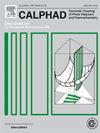Catastrophe theory and thermodynamic instability to predict congruent melting temperature of crystals
IF 1.9
3区 材料科学
Q4 CHEMISTRY, PHYSICAL
Calphad-computer Coupling of Phase Diagrams and Thermochemistry
Pub Date : 2024-11-04
DOI:10.1016/j.calphad.2024.102761
引用次数: 0
Abstract
Melting temperature (Tm) is a crucial physical property of solids and plays an important role in the characterization of materials. Therefore, the capacity to predict Tm is a relevant issue for solid state sciences. This investigation aims i) to provide a theoretical basis for the link between catastrophe theory and thermodynamic instability; ii) to estimate Tm through the notion of “degenerate critical temperature” (Td), related to (Pd,Vd,Td), where KT → 0 and the Gibbs function shows a non-Morse behaviour; iii) to compare predictions of (Pm,Tm) with observations for three crystalline pure substances that undergo congruent melting and exhibit different bonding and stability ranges: NaCl (halite), SiO2,st (stishovite), and MgSiO3 (perovskite). The P-T locus of KT = 0 associated with melting is identified using the maximum values of Td and ΔH/ΔV at a given pressure. We observed an average absolute discrepancy ranging between 0.2 % (halite) and 5.8 % (stishovite), and an agreement between theoretical and experimental T(P)melting-points from better than 1 to approximately 14 %.
用灾难理论和热力学不稳定性预测晶体的同熔温度
熔融温度(Tm)是固体的一项关键物理特性,在材料表征中发挥着重要作用。因此,预测 Tm 的能力是固体科学的一个相关问题。这项研究旨在 i) 为灾难理论与热力学不稳定性之间的联系提供理论依据;ii) 通过与 (Pd,Vd,Td) 相关的 "退化临界温度"(Td)概念估算 Tm,其中 KT → 0 且吉布斯函数显示非莫氏行为;iii) 将 (Pm,Tm) 的预测结果与对三种晶体纯物质的观察结果进行比较,这三种物质会发生同熔,并表现出不同的键合和稳定性范围:NaCl(海绿石)、SiO2,st(石英)和 MgSiO3(透辉石)。利用给定压力下 Td 和 ΔH/ΔV 的最大值,确定了与熔化相关的 KT = 0 的 P-T 位置。我们观察到的平均绝对差异范围在 0.2 %(海泡石)和 5.8 %(菱锰矿)之间,理论和实验 T(P)熔点之间的一致性从优于 1 % 到大约 14 % 不等。
本文章由计算机程序翻译,如有差异,请以英文原文为准。
求助全文
约1分钟内获得全文
求助全文
来源期刊
CiteScore
4.00
自引率
16.70%
发文量
94
审稿时长
2.5 months
期刊介绍:
The design of industrial processes requires reliable thermodynamic data. CALPHAD (Computer Coupling of Phase Diagrams and Thermochemistry) aims to promote computational thermodynamics through development of models to represent thermodynamic properties for various phases which permit prediction of properties of multicomponent systems from those of binary and ternary subsystems, critical assessment of data and their incorporation into self-consistent databases, development of software to optimize and derive thermodynamic parameters and the development and use of databanks for calculations to improve understanding of various industrial and technological processes. This work is disseminated through the CALPHAD journal and its annual conference.

 求助内容:
求助内容: 应助结果提醒方式:
应助结果提醒方式:


